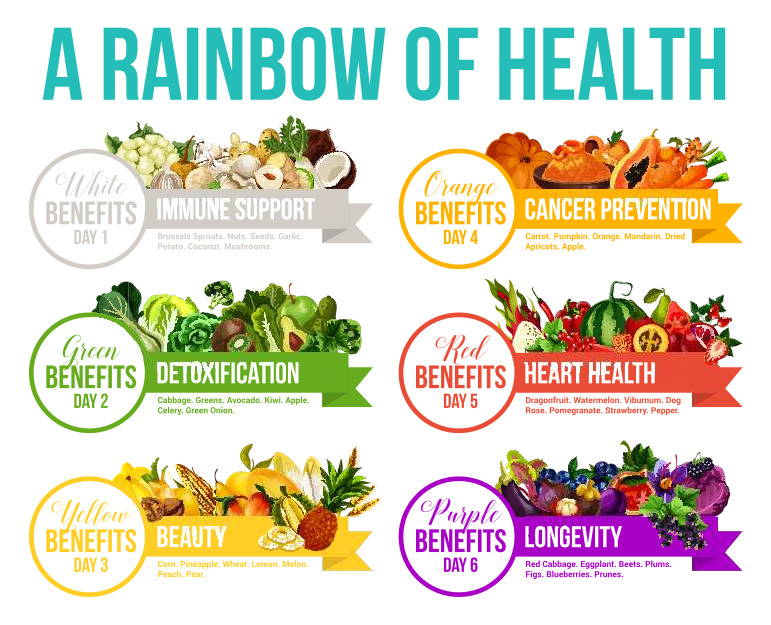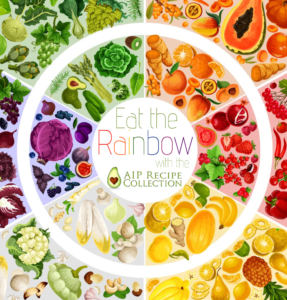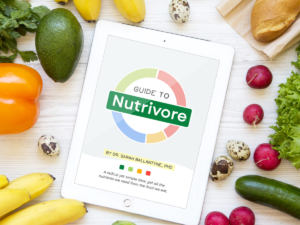Eat The AIP Rainbow
This post contains affiliate links. Click here to see what that means.

If you’re on the AIP (Autoimmune Protocol) elimination diet, you may or may not realize that our goal is nutrient density – and that means LOTS and LOTS of colorful fruits and veggies.
Since the AIP is actually a modification of the Paleo Diet, some people get confused and think of it as the carnivore diet – but it’s definitely NOT that.
So, does that mean the it’s a vegetarian, vegan, pegan or pescetarian diet? Nope! While it’s definitely veggie-centric with 8 servings or more of vegetables and fruit per day, it’s actually not recommended to do the AIP as a vegetarian or vegan (you can read more about that here).
We need to find balance on the AIP and focus on healing nutrients. You want to become a “Nutrivore!”
While I’m usually pretty good at eating a variety of fruit and veg, a recent chat with my Functional Medicine Practitioner helped to bring it back to top of mind and it inspired me to share this with you too since I’m often asked about serving sizes, variety and how to get more fruit and veg into our diets.
How Much is a Serving?
I get this question a LOT when ever I reference the “8+ servings” goal. I’ll let Dr. Sarah Ballantyne’s article, The Importance of Vegetables, do the explaining here:
The standard vegetable and fruit serving size established by the World Health Organization in 2005, and used in more scientific studies evaluating benefits of high vegetable and fruit consumption, is defined as 80 grams raw, or just shy of 3 ounces.
This roughly translates to:
- 1 cup raw vegetables
- ½ cup cooked vegetables
- 2 cups raw leafy greens
- 1 medium fruit (about the size of baseball)
- ½ cup chopped fruit (or berries)
- ½ cup cooked fruit
If you’re concerned with getting enough veggies in, you’re going to want to stay tuned and check out the resources at the end of this post that will help you stay on track, increase awareness of your vegetable intake and whether or not it meets your healing goals. It’s the easiest and most intuitive way to ensure we’re getting enough veggies, fruit and high-quality meat and seafood into our diets weekly – no perfectionist tendencies, no guilt!
Eat the AIP Rainbow
 While there are diets out there focused on helping you eat the rainbow every day, they’re not really suitable for the AIP, since we avoid some brightly colored options during the elimination stage (think nightshades like peppers, eggplant, beans, tomatoes and more that are out in the beginning. Looking for AIP food lists? – click here.)
While there are diets out there focused on helping you eat the rainbow every day, they’re not really suitable for the AIP, since we avoid some brightly colored options during the elimination stage (think nightshades like peppers, eggplant, beans, tomatoes and more that are out in the beginning. Looking for AIP food lists? – click here.)
So, what’s an AIP-er to do?
First of all, mindset is HUGE! Always look at the CANs instead of the CAN’Ts! There’s an abundance of nutrient dense options we can choose from. Just look at this image – almost all of the fruits and veggies are suitable for every stage of the AIP.
It’s really a matter of re-training ourselves. We need to look past our old go-to choices – why not venture out of our comfort-zone and wander into areas of the produce section you might have skipped before? Make it a goal to take home at least ONE compliant fruit or veggie that you’ve never tried before (or that you rarely eat). Browse the AIP Recipe Collection Group on Facebook (where our big database of AIP recipes lives) for ways to prepare your new-found food – you’ll usually find at least a couple of options. Not finding many recipes there that suit your fancy? Try an Internet search for “AIP [insert vegetable or fruit name here] Recipes” and share one with the group as a new post so that we can all be inspired and try something new.
How-To Eat the AIP Rainbow!
Stuck in a rut and not sure how to get out? Here are a few tips to putting more colorful variety on your plate!
- Try Something New: As I mentioned above – try something new! If you have kiddos, assign them the task – they’ll be even more excited to try it once you get home. Have you ever had star fruit or dragon fruit? How fun are they!
- Go Rainbow-Inspired: Some dishes lend themselves to incorporating lots of colors – think about a great big stir-fry or breakfast hash, or maybe AIP egg-roll in a bowl … how many colors can you squeeze in?
- Top It Off: Dish looking a little bland? It’s not too late to reach for some colorful fruit or veggie toppings.
- Mix Them In: You don’t have to use everything in it’s traditional sense. A great example of that is cauliflower, which seems capable of just about anything these days! Zucchini and avocados can go undetected in smoothies and sauces.
- Prep Them Differently: Bored with steamed veg? I hear ya! I much prefer roasting or broiling them – I find the cooking process really changes up the flavor. How about a little smoky BBQ infusion? You can even grill your lettuce! (Check out my Grilled Caesar.)
- Dip It: There are lots of inventive AIP dips that you can make out of veggies – beet or cauliflower hummus come to mind. Double dip by dipping into your veggie dip with more of them or use it as a spread on a sandwich with a lettuce wrap/bun.
- Sip a Smoothie: Some of our least-loved veggies and herb go great in smoothies, but they’re the tops when it comes to nutrient density! Try kale, spinach, cilantro, parsley, cucumbers, zucchini and more!
- Desserts and Snacks: Try using fruit instead of over-indulging in sugar-laden options. How about some avocado mousse? An apple with a spread of caramel made from dates TigerNut or Coconut Butter? Try the group search in my AIP Recipe Collection Group on Facebook or my AIP Snack Guide.
- Use Your Freezer: Fresh produce spoils quickly, so be sure to extend its usefulness by freezing it before it goes bad. There are lots of tips on the Internet for how to best preserve fruits, veg and herbs for later use. Also, don’t poo-pooh the idea of buying pre-packaged frozen options – they’re often flash frozen at the height of ripeness and they have just as many nutrients and their fresh counterparts.
- Nerd Out with Nutrivore: Learning more about fruits and veggies and concentrating on those that can move us forward on our healing journey is a great way to get motivated to eat more of the right things. Using the Nutrivore Serving Matrix is a fun way to stay accountable without falling into the perfectionist trap of dieting. Keep reading to learn more!
Become a Nutrivore!
 If you’ve been following the AIP for a while, you’re probably familiar with the aforementioned Dr. Sarah Ballantyne – she’s sort of a big deal! She’s the scientific Doc who helped “pioneer,” The Autoimmune Protocol – yep, she even wrote the book! What’s amazing about Dr. Sarah, is the fact that she never stops! She didn’t just create the protocol and let it end there … she continued researching, working on medical studies and updating it to what we have today.
If you’ve been following the AIP for a while, you’re probably familiar with the aforementioned Dr. Sarah Ballantyne – she’s sort of a big deal! She’s the scientific Doc who helped “pioneer,” The Autoimmune Protocol – yep, she even wrote the book! What’s amazing about Dr. Sarah, is the fact that she never stops! She didn’t just create the protocol and let it end there … she continued researching, working on medical studies and updating it to what we have today.
But wait, there’s more! Taking it a step further, Dr. Sarah has combined her book smarts and nutritional research with her experience working with real-world autoimmune sufferers and expanded her approach to healing. While she still encourages us to personalize our AIP or Paleo diet, she wants to help us become Nutrivores using her “Guide to Nutrivore” resources and her book “Nutrivore: The Radical New Science for Getting the Nutrients You Need from the Food You Eat”
Wait, what!? More rules to live by, more restriction!?
Absolutely not! In her real world experience, Dr. Sarah has come to realize that “diet culture” can create food fears and disordered eating. This is not the fault of the protocol, but the failure of users to implement it properly (elimination stage PLUS reintroduction of healthful foods). Remember: Our goal on the AIP is nutrient density and achieving an understanding of what works best for our own body and health condition.
Nutrivore is a diet philosophy that focuses on the quality of your diet – a tool that can help EVERYONE find balance and health through nourishment, not judgement.
I LOVE that Dr. Sarah’s Nutrivore resources are NOT emphasizing perfection. That’s right, everything doesn’t have to be organic (even if you’re on a budget you can still be a Nutrivore), serving sizes and measurements don’t have to be precise (the serving matrix is amazing at teaching you approximate sizes using your hand), you don’t have to over-think it and eat like a nutritionist every day, AND you don’t have to track every single thing that you eat! With Nutrivore, you’re focusing on the positive – the healthiest foods you’ve eaten – such a mentally healthy approach. Thank you Dr. Sarah – I LOVE it! ♥
Does that mean that Dr. Sarah is ditching The Autoimmune Protocol and the elimination diet?
Absolutely not! The AIP / elimination diet remains the gold standard for discovering food sensitivities – at this time, there is no replacement for this process – not even food sensitivity testing (read more here). Nutrivore can go hand-in-hand with the AIP, helping you ensure you’re reaching at least nutrient sufficiency if not nutrient density. Did you know that many on the AIP don’t eat enough? Hardly surprising since many are left feeling there’s nothing left to eat during the elimination stage. If you’re eating the rainbow, you’ll quickly find out that this is NOT the case, and “The Guide to Nutrivore” and the accompanying weekly serving matrix check lists will help ensure you’re satisfying your body’s needs.
The Nutrivore approach is meant to help you get the most out of your efforts to eat a healthy, healing diet by concentrating on foods that offer the MOST nutrient density to meet your body’s needs. And THAT is why I’m introducing you to it here in my post about eating the rainbow.
If you want to learn which foods will give you the most healing “bang” for your buck, Dr. Sarah’s “Nutrivore” resources are just what you need! Click here to learn more. I HIGHLY recommend you pick up the Digital Collection – Paired with The Nutrivore Guide, the Nutrivore Weekly Serving Matrix and Video Tutorial takes it to the next level – so much amazing information!

